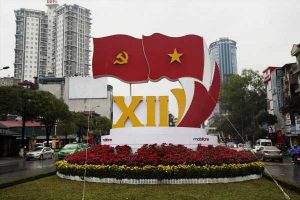The Secretive Meeting Where Vietnam Changes Leaders

Vietnam, one of the world’s five remaining Communist states, is about to get new leadership. The biggest moves will emerge from a secretive, twice-a-decade meeting — the National Party Congress — which gets underway in Hanoi in late January. From general secretary on down, there’ll be a shakeup of the characters who will steer the Southeast Asian nation of 97.6 million people through a period of tense relations involving China and the U.S. While no major policy reset is anticipated, the congress will approve a five-year blueprint for one of the world’sfastest-growing economies.
1. How does the system work?
It’s an opaque process. Vietnam has a collective “four pillar” leadership structure made up of general secretary, prime minister, president and chair of the National Assembly, the nation’s parliament. It governs in consultation with a 17- to 19-member politburo. Nguyen Phu Trong, the current general secretary, also becamepresident in 2018 following the death of President Tran Dai Quang, meaning the top leadership was down to three. Observers anticipate the government will revert to four pillars in 2021.
2. Who chooses what?
The 13th National Party Congress is scheduled to be held Jan. 25 through Feb. 2. About 1,600 delegates from across the country will vote to select about 200 members to the Central Committee, which in turn will pick the politburo and from that group the party general secretary. The politburo will then nominate candidates for prime minister and the cabinet. These will go to a vote in the National Assembly mid-year.
3. Who’s in contention for the top job?
Prime Minister Nguyen Xuan Phuc, 66, who has won plaudits for guiding the country through the pandemic relatively unscathed, may be in the running for the party chief. His chief rival could be the incumbent’s protege, Tran Quoc Vuong, 67, head of the party’s central office, who spearheaded Trong’s aggressive anti-corruption campaign. Trong, 76, may even pursue another full or partial third term. Possible contenders for other top jobs:
- Vuong Dinh Hue, 63, a former minister of finance, deputy prime minister and head of the Party’s Central Economic Commission, may be in the running for prime minister.
- Foreign Minister Pham Binh Minh, 61, who holds a master’s degree from Tufts University in the U.S. and is also deputy prime minister, is a possible candidate for president.
- Truong Thi Mai, 62, a Central Committee member, could be the second woman elected as chair of the National Assembly.
4. What challenges await?
On the one hand, boosting growth in the export-dependent nation following a sharp global recession. On the other, doing so without further upsetting the U.S., its biggest export market. The U.S. put Vietnam on notice in October by opening a tradeinvestigation into its currency policy and thenimposed preliminary anti-subsidy duties on Vietnamese car and truck tires, citing an “undervalued currency.” In December, the U.S. Treasury designated the Southeast Asian country acurrency manipulator, which comes with no immediate penalties but can escalate trade tensions. Vietnam’s authorities will be keen to secure greater access to American consumers while tamping down concerns about the surging trade surplus, on pace in 2020 to break the previous year’srecord $56 billion.
5. How has Covid-19 affected the country?
At year-end Vietnam had one of thelowest virus death counts globally, having contained the pathogen. However, economic growthslowed to 2.91% at the end of 2020 as the global downturn brought on by the pandemic sapped demand for made-in-Vietnam products, from smartphones to dress shirts. The government forecasts a 2021expansion of about 6% compared with 7.02% in 2019.
6. What about superpower relations?
Vietnam depends on China for key materials and equipment to supply its factories. Yet relations with its powerful neighbor — the two countries fought a brief border war in 1979 — are fraught and further inflamed because ofcompeting territorial claims in the South China Sea. (Vietnam’s coastline of about 3,400 kilometers, or 2,100 miles, follows one of the world’s busiest sea cargo lanes.) Vietnam favors greater U.S. economic and military presence in the region to counter China’s growing might and is expected topush for a close relationship with the Biden administration.
7. How are Vietnamese faring?
As decades of market-oriented economic reforms boost incomes and nurture a growing middle class, Vietnam is among the world’s mostoptimistic countries, according to a Nielsen survey. Yet human rights advocates criticizerestrictions of basic political and civil freedoms. Arrests and trials of Vietnamese who speak out on issues such as corruption have grown markedly following a new cybersecurity law in 2019, according to Carl Thayer, emeritus professor at the University of New South Wales in Australia. There’s typically anup-tick in arrests before the party congress, he said.
8. What will a new government mean for investors?
More of the same. Vietnam’s successful handling of the pandemic, improving infrastructure, investor-friendly policies, political stability and its well-educated, young and low-cost workforce is likely to continue attracting international companies. Expect further efforts by the new leadership to sell Vietnam as an increasingly high-tech manufacturing base for suppliers of global giants such asApple Inc. One concern for companies will be the risk that the trade rift with the U.S. could trigger additional tariffs.
The Reference Shelf
- Bloomberg News looks at how shifting supply changes bringprosperity to Vietnam’s poorer regions, as its leaders sought tonavigate between the U.S. and China.
- How Vietnam aims toreset its volatile relationship with the U.S. under Joe Biden.
- The Brookings Institution says Vietnam’s improvinggovernance helped it contain the pandemic within its borders.
- Communist Party General Secretary Nguyen Phu Trongwrote an article about preparation for the congress.
Source: Read Full Article
